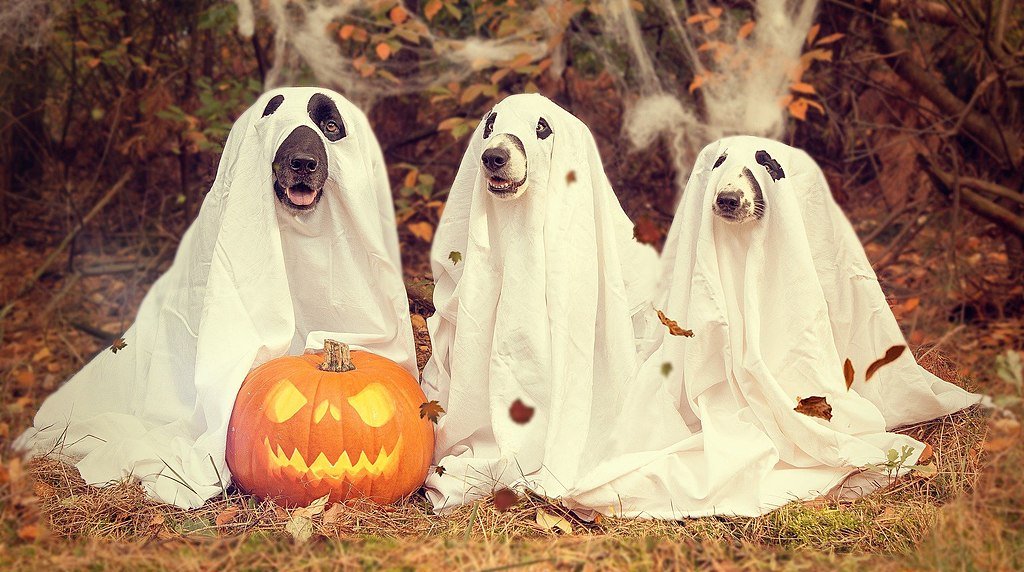23 October 2023
One of pitfalls in thinking about language is the recency illusion, the idea that a word or phrase is of rather recent vintage when in fact it is much older. Even experts can fall victim to this cognitive bias. I did with the term spooky season, referring to the season leading up to Halloween. Since I had only recently noticed the term, I had thought the alliterative phrase was rather new, when it is actually over a century old.
The earliest appearance of spooky season that I have found is in a headline in the Whittier Daily News for 1 November 1905. The California newspaper places the word spooky in quotation marks, indicating that the editors did not yet consider it a stock phrase:
Mirthful Events
Halloween Parties Many and Delightful
“Spooky” Season is Observed
The next year, another California paper, the Fresno Morning Republican, did the same on 27 October 1906:
This concluded the conventional part of the evening, later the audience being escorted to the social hall down stairs, where ghosts and hobgoblins, pumpkins and apples vied with each other in carrying out the Hallowe’en sentiment. At a mysterious fortune telling booth in one corner the present, past and future was the subject of the witches’ discourse, and all the tricks known to the “spooky” season were tried. The affair was most successful in every way and the ladies are to be congratulated upon having entertained well.
But a week later we get spooky season without any quotation marks in New Orleans’s Daily Picayune of 4 November 1906:
Misses Bertie Moore and Stella Relly entertained the Young Ladies’ Auxiliary to the Y.M.C.A. at a social in which Halloween was celebrated, Wednesday afternoon. The young hostesses, beautifully gowned in white, received their guests in a darkened parlor illuminated only by grotesque jack-o’-lanterns. All the mysticisms of the spooky season bewitched the guests, whose fortunes were told by two forlorn witches that resided in a darkened tent. The refreshments served were appropriate to the occasion.
And within a few years we see the phrase in papers from the Midwest. Omaha’s Evening World-Herald of 28 October 1911 has this:
Ghosts, ghosts everywhere; in the yard, on the porch, in the hall and every room in the home of Mr. and Mrs. Jay Laverty of South Omaha, who entertained at a Halloween party Friday evening for the members of the Frances Willard union of the Women’s Christian Temperance union. The beautiful home of Mr. and Mrs. Laverty had a most elaborate decoration of autumn leaves and yellow pumpkins cut from cardboard. The green and yellow eyes of black cats gleamed from dark corners, and witches with their brooms swept all the remaining cobwebs from the spirits of the guests.
Upstairs, in the attic, there was a wealth of decoration, all suggestive of the “spooky” season. A gayly dressed gypsy read palms and foretold all sorts of good fortunes for the guests.
A buffet supper of doughnuts, apples, and coffee was served to the 200 guests present. Before going to the attic, a delightful musical program was given by Mr. James Colvin, who has recently returned from abroad. Mrs. Richabau of South Omaha sang a solo in a most pleasing manner.
And this from Iowa’s Atlantic Evening News of 1 November 1911:
Hallowe’en is always the season for many delightful social affairs and this year was no exception to the rule in that respect for there were many pleasant affairs about the city and in this vicinity last evening, appropos [sic] the spooky season.”
But those of us who have fallen victim to the recency illusion regarding spooky season are not completely off the mark. The phrase has skyrocketed in popularity in recent years. The News on the Web (NOW) Corpus, which tracks usage in online newspapers and magazines shows that between 2011 and 2015 the phrase’s appearances in the corpus number in single digits. It rises to double digits in 2016, and then jumps to over two hundred appearances in 2019. Since then, there has been a steady rise in spooky season’s frequency, reaching 854 in 2022. It’s too early to tell what the number for this year will be, but it looks like last year was peak spooky season. Whether that marks the beginning of a declining trend or if the frequency is just leveling off remains to be seen.
Sources:
Davies, Mark. Corpus of News on the Web (NOW), accessed 7 October 2023.
“Mirthful Events.” Whittier Daily News (Whittier, California), 1 November 1905, 1/2. Newspapers.com.
Schwedel, Heather. “When Did this Time of Year Become ‘Spooky Season’?” Slate.com, 19 October 2021.
“Social and Club News.” Fresno Morning Republican (Fresno, California), 27 October 1906, 8/4. Newspapers.com.
“Social Events of the City.” Atlantic Evening News (Atlantic, Iowa), 1 November 1911, 1/1. NewspaperArchive.
“Social Whirl.” Evening World-Herald (Omaha, Nebraska), 28 October 1911, 4/1. Readex: America’s Historical Newspapers.
“Society.” Daily Picayune (New Orleans, Louisiana), 4 November 1906, Section 2, 4/3. Readex: America’s Historical Newspapers.
Photo credit: Aglampet Gruodje, 2020. Wikimedia Commons. Licensed under a Creative Commons Attribution-Share Alike 4.0 International license.

